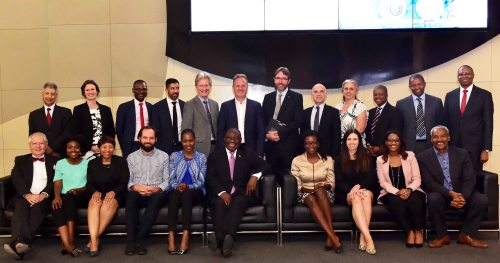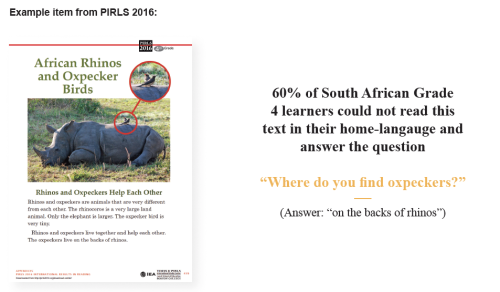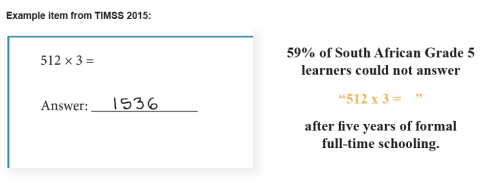Note: This article first appeared on Nic Spaull’s website on 3 December 2018 and can be accessed here. Additionally, download his 3-page report here.
Presentation to the president
At a roundtable discussion with President Cyril Ramaphosa in Sandton last week (Thursday, 22 November 2018), Dr Nic Spaull, Senior RESEP Researcher, spoke about the importance of restoring our malfunctioning primary education system. He commented that “Our primary education system is the binding constraint to economic growth and shared prosperity in the long-run.” Dr Spaull was one of 18 economists from academia and industry who were invited by the presidency to give input on the following focus area:

Strategies for Long-term Prosperity
“What would it take to place SA on a higher-growth trajectory?”
Overview: The president has asked about two things (1) How to increase economic growth, and (2) how to share the gains of that growth. This note argues that neither of these two things are possible with the current broken primary education system. Currently less than half of South African children acquire basic skills in literacy or numeracy in primary school, they do not pass matric and they do not get jobs. The dysfunctional basic education system is the binding constraint to long-term inclusive economic growth. Ensuring all children learn to read-for-meaning and calculate-with-confidence by age 10 must become the apex priority of government. There is no route to a more equitable and prosperous South Africa that does not first chart the path of a radically improved primary education system. This is a difficult sell in the short-term but it is really the only way to a truly transformed South Africa.
THE PROBLEM
- Mass unemployment: Half of all young people aged 15-34 years are unemployed by the broad definition (StatsSA, 2018) and the problem is getting worse. The unemployment rate for those under 24 years of age has risen since 2010 and the percentage of youth who have given up looking for work has also increased (De Lannoy et al., 2018: p7). This has also lead to a sense of exclusion among young people and heightened ‘levels of frustration and impatience’ (National Planning Commission 2012).
- Severe inequality and a legacy of exclusion: South Africa today is the most unequal country in the world. The richest 10% of South Africans lay claim to 65% of national income and 90% of national wealth; the largest 90-10 gap in the world (Alvaredo et al, 2018, p. 150; Orthofer, 2016). Wealth and access to dignified work are still split along racial and geographic lines with poverty and unemployment concentrated among African and female youth, especially those living in rural areas and townships. White South Africans still make up two-thirds of the elite (the wealthiest 4% of society).
Figure 1: Racial composition of South Africa’s ‘classes’ (Source: Schotte et al, 2017: p.25). (Rand values are mean household expenditure per capita).

THE ROOT OF THE PROBLEM
The dysfunctional primary schooling system: Of 100 children that start school, approximately 60 will reach and write matric, 37 will pass and 12 will access university. Only 4 will complete an undergraduate degree within 6 years. Low through-put rates and weak performance in high school is rooted in weak foundations from primary school (Spaull & Kotze, 2015, Van der Berg et al., 2016).
Figure 2: The qualifications pyramid in South Africa (Van Broekhuizen et al., 2016)

Lack of foundational reading skills: Learning to read for meaning is the most critical skill children learn in primary school. It is the skill upon which all other skills depend. The South African curriculum stipulates that children should be able to read for meaning by the end of Grade 3 in their home-language and in English. The recent Progress in International Reading Literacy (PIRLS 2016) study showed that 78% of South African Grade 4 children could not read for meaning in any language, that is they could not “locate and retrieve an explicitly stated detail.” Comparable figures in other countries are 64% (Morocco), 35% (Iran), 13% (Chile), and 3% (United Kingdom) (Mullis et al., 2017a).

Lack of foundational mathematical skills: Learning to use the four operations effectively and with confidence is one of the most essential mathematical skills children learn in primary school. According to the Trends in International Mathematics and Science Study (TIMSS 2015), 61% of South African Grade 5 learners could not do basic mathematics, that is they could not add and subtract whole numbers, have no understanding of multiplication by one-digit numbers and cannot solve simple word problems. (Mullis et al., 2017b)

THE SOLUTION
Radical prioritisation and focusing on Foundation Phase: The first step towards fixing the education system is ruthless prioritisation. South Africa does not have the financial resources, political capital or human expertise to solve many problems at the same time. Policy-makers and politicians need to accept that underperformance in matric and high drop-out rates are rooted in weak foundations in primary school and specifically in Grades R-3. If 78% of Grade 4s cannot read for meaning in any language they are precluded from success at school. In mathematics, only a third of South African children are equipped to succeed which can reliably be traced back to primary school. We typically look at the approximately 360,000 matrics who pass (30%+) either Maths or Maths Literacy in 2017 which is about 36% of the original cohort. Yet if we look at Grade 9 we see that only 34% of Grade 9s could do basic maths (TIMSS 2015), and if we look even earlier at Grade 5 we see that only 39% of Grade 5s acquired basic numeracy (TIMSS-N 2015).
Business-as-usual is not working: Although there were considerable gains in learning outcomes in the 2003-2011 period, the 2011 to 2015 period has shown almost no improvement in learning outcomes (Spaull, 2019). Grade 4 reading outcomes did not improve between PIRLS 2011 and PIRLS 2016.
A ‘Marshall Plan’ for early grade reading and numeracy focusing on teachers: Reforming the basic education system is not possible without changing (1) who is recruited into teaching, (2) the way that teachers are trained at universities and in schools, (3) the ways that teachers are deployed across schools, and (4) who has access to the functional part of the schooling system. None of these reforms are possible without significant buy-in from the majority teacher union, SADTU, which is itself not possible without the ruling party expending significant political capital. Being more selective about who is accepted to teacher training programs, providing existing teachers with meaningful learning opportunities, and incentivising the best teachers to teach in the most challenging contexts will not be possible without additional resources and political will. We need a “Marshall Plan” for Reading and Numeracy and to drastically expand promising programs like the Early grade Reading Study (EGRS), which have been piloted, rigorously evaluated and shown to be successful in the North West and Mpumalanga. With a small army of reading coaches, resources, and lesson plans you could reach half of all primary schools within 8 years. It would cost R1,3billion per year.
A wise president: It’s true that there is no silver bullet for improving basic education, and yes, change in education takes a long time – certainly more than one term. However, there is no route to a more equitable and prosperous South Africa that does not first chart the path of a radically improved primary education system. A wise president, and one who will almost certainly win the election in May 2019, would realise that while improving basic education is a difficult sell in the short-term, it is really the only way to a truly transformed South Africa.







